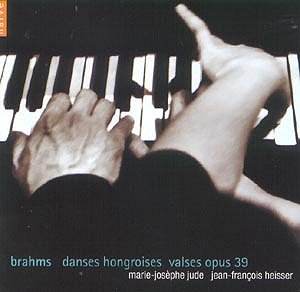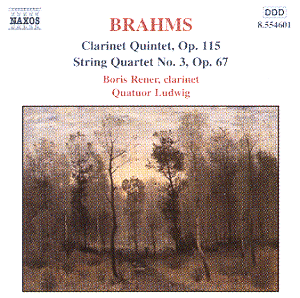 Composer: Johannes Brahms
Composer: Johannes Brahms
Works: Hungarian Dances, Waltzes, performed by Marie-Josephe Jude & Jean-François Heisser
Recording: Naïve V 4892 (67 mins)
Released: January 2001
Location of Recording: Marseille
Label: Erato
In the realm of Brahmsian performance, the current recording of the Hungarian Dances and Waltzes, Op. 39 by the piano duet of Marie-Josephe Jude and Jean-François Heisser merits attentive consideration. This 2001 release, captured in the vibrant acoustics of Marseille, showcases the duo’s agility and interpretative insight, shedding light on two of Brahms’ most beloved collections, originally conceived for piano four hands.
Brahms’ Hungarian Dances, a series of folk-inspired pieces, reflect his fascination with the Hungarian musical idiom, drawing upon melodies that were not originally his own but were transformed through his distinctive lens. The dances, composed in 1869 and 1880, are infused with a rhythmic vitality and rich harmonic language that often belies their folk origins. Jude and Heisser navigate this terrain with commendable fluency, allowing Brahms’ characteristic polyrhythmic textures to resonate with both precision and spontaneity. Their interpretation is particularly notable for its balance: the rhythmic drive is exhilarating without sacrificing the lyrical nuances inherent in Brahms’ writing.
The recording begins with Hungarian Dance No. 1 in G minor, where the duo’s articulation of the syncopated rhythms is both crisp and lively. The thrust of the opening theme is punctuated by their dynamic contrasts, which effectively mirror the ebb and flow of Hungarian folk dance. The second dance, No. 5 in G minor, reveals their ability to convey the contrasting moods of melancholy and exuberance, with a seamless exchange of thematic material that makes one forget the individual players—an achievement that Heisser himself acknowledges in the interview notes accompanying the disc.
The Waltzes, Op. 39, composed in 1867, present a different challenge—one of lyrical expressiveness. Here, Jude and Heisser exhibit a deep understanding of Brahms’ subtleties. In Waltz No. 15, for instance, the gentle unfolding of the melody is treated with a delicate touch, allowing the underlying harmonic shifts to emerge naturally. The duo’s phrasing is particularly effective; they eschew overt sentimentality, opting instead for a restrained elegance that evokes the essence of the waltz form. This approach, while less flamboyant than some interpretations—such as those by the famed duo of Ashkenazy and Previn—proves to be equally compelling, revealing layers of complexity that might otherwise be overshadowed by a more exuberant execution.
Recording quality plays a significant role in the overall impact of this release. The engineering captures the warmth and clarity of the piano, preserving the intricate interplay between the two players. The spatial separation of the voices is managed with care, allowing the listener to appreciate the dialogue that unfolds between Jude and Heisser. The instrument’s resonance is particularly palpable in the quieter passages, where the subtleties of Brahms’ writing come to the fore.
Historically, Brahms’ Hungarian Dances and Waltzes occupy a unique position within the composer’s oeuvre, existing as both popular concert works and testaments to his skill in orchestrating folk idioms within a classical framework. Their continued popularity is a testament to Brahms’ ability to transcend stylistic boundaries while remaining rooted in the traditions he so admired.
In conclusion, Marie-Josephe Jude and Jean-François Heisser’s recording of Brahms’ Hungarian Dances and Waltzes stands as an eloquent testament to the duo’s artistry. Their interpretative choices—marked by a keen sense of balance between accuracy and spontaneity—offer listeners an engaging and thoughtful experience. The engineering enhances their performance, allowing Brahms’ intricate textures to shine. This recording serves not only as a delightful entry point into Brahms’ world but also as an affirmation of the enduring appeal of his music, rendered with sensitivity and skill.



